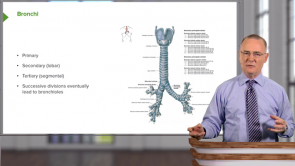Blood Supply and Innervation – Breast

About the Lecture
The lecture Blood Supply and Innervation – Breast by Craig Canby, PhD is from the course Abdominal Wall with Dr. Canby.
Included Quiz Questions
Which major arteries supply blood to the breast?
- Axillary, internal thoracic, and intercostal
- Axillary, femoral, and popliteal
- Internal thoracic, intercostal, and brachial
- Axillary and brachial
- Axillary, brachial, and femoral
Where is the major lymphatic drainage of the breast?
- Axillary lymph nodes
- Parasternal lymph nodes
- Breast lymph nodes
- Internal mammary lymph nodes
- Thoracic lymph nodes
Where are the level 3 axillary lymph nodes located?
- Medial to the pectoralis minor
- Lateral to the pectoralis minor
- Beneath the pectoralis minor
- Medial to the pectoralis major
- Lateral to the pectoralis major
What is the other name for the parasternal lymph nodes of the breast?
- Internal mammary lymph nodes
- Axillary lymph nodes
- Cervical lymph nodes
- Thoracic lymph nodes
- Intercostal lymph nodes
Which lymph nodes receive 75% of the lymph that drains from the breast?
- Axillary nodes
- Parasternal nodes
- Abdominal nodes
- Intercostal nodes
- Subclavian nodes
Customer reviews
5,0 of 5 stars
| 5 Stars |
|
5 |
| 4 Stars |
|
0 |
| 3 Stars |
|
0 |
| 2 Stars |
|
0 |
| 1 Star |
|
0 |

![Anatomy [Archive]](https://assets-cdn1.lecturio.de/lecture_collection/image_medium/87992_1693919964.png)


